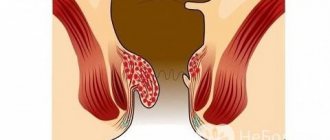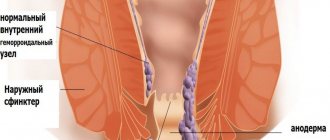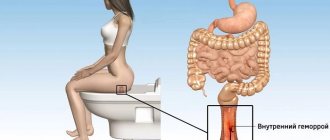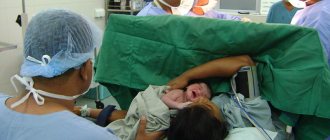Stage 4 hemorrhoids are very difficult. During this period, the patient experiences pain, itching, bleeding and a constant burning sensation in the anal area. What treatment is prescribed in advanced stages of hemorrhoidal disease?
Qualification of the disease distinguishes four degrees of development of pathology
With hemorrhoids, deformation of the veins in the walls of the rectum occurs. In this case, severe swelling of the hemorrhoids occurs. They move down and fall out. Blood clots can form in them and bleeding can occur.
Depending on the shape of the hemorrhoids and the level of development of dystrophic processes in the area of the fibromuscular framework, four stages of development of the chronic disease are distinguished. Thus, for grades 1 and 2 of the chronic course of the disease, conservative treatment methods and minimally invasive therapy are used. At stages 3 and 4, hemorrhoidectomy (surgical intervention) is used.
| Advanced degree of hemorrhoids | |
| Why is the disease dangerous? | Lack of therapy leads to insufficiency of the anal sphincter, pinched and prolapsed nodes, and excessive bleeding that is life-threatening. |
| Will pills help? | At the last stage of development of a proctological disease, medications do not treat, but only relieve pain. |
| Which doctor will help? | Coloproctologist or surgeon. |
| How to treat | Only surgical intervention will help. Depending on the symptoms, it is recommended to perform open and closed hemorrhoidectomy, submucosal Parks operation, and hardware hemorrhoidopexy. |
Symptoms characterizing stage 4 of the disease
The disease progresses to such a complex stage if it is not diagnosed in time and treatment is neglected. Stage 4 hemorrhoids have the following symptoms:
- The sphincter muscles lose their former elasticity, which is why hemorrhoids fall out;
- Prolapsed hemorrhoidal cones are clearly visible, causing physical and psychological inconvenience to the patient;
- At this stage, it is not possible to set the fallen nodes on your own;
- The patient constantly experiences a feeling of pain, especially when sitting, walking or during bowel movements;
- During bowel movements, heavy bleeding occurs;
- Systematic blood loss leads to a decrease in hemoglobin, causing deterioration of health, dizziness;
- The patient is bothered by burning and itching in the anus area;
- Random discharge of gases and liquid feces occurs, which in turn can cause damage to the epithelium in the anal area;
- Thrombosis and tissue necrosis.
Photos of hemorrhoids at various stages
What hemorrhoids look like in women and men will depend on the stage of the pathological process. Traditionally, there are 4 degrees of severity of negative symptoms, and the basis for assigning the disease to one or another stage is the possibility of nodes falling out of the rectum.
Since only a doctor can determine the level of neglect of the hemorrhoidal process after a diagnostic examination, below are only the main signs of each degree, as well as photographs of the disease.
First stage
As we have already noted, hemorrhoidal disease can begin unnoticed, but proceed painlessly and even asymptomatically.
In the photo you can hardly notice a small hemorrhoid - a small reddish formation, slightly protruding from the mucosa or epithelium.
And yet, the following signs of hemorrhoids in women and men can be identified at the initial stage of the process:
- discomfort during stool eruption;
- mild irritation of the anus;
- flatulence;
- feeling of incomplete bowel movement;
- minor bleeding.
Beginning hemorrhoids can be easily treated with a combination of medications, diet and lifestyle changes. Contact a proctologist at the first discomfort in the rectum and anus to stop the progression of the disease.
Second stage
Hemorrhoids in girls and men are most often discovered precisely at this phase, when its characteristic symptoms appear: pain during bowel movements, mucus discharge, itching, droplets of blood almost every time you visit the restroom.
The main difference between this stage and the initial stage is that hemorrhoidal nodules begin to emerge when you strain and pass feces. But since changes in the muscular-ligamentous apparatus of the rectum are not yet very pronounced, the fallen formations return on their own.
Another characteristic symptom is the feeling of the presence of a foreign object in the anal canal. Such symptoms are a good reason to visit a proctology office. At the second stage of hemorrhoids, conservative therapy also prevails.
https://youtu.be/b5iY1uDwkmE
Treatment of hemorrhoids
All 4 stages of hemorrhoids
Before studying in detail the methods of treating hemorrhoids 4, advanced stage, it is worth considering what kind of treatment can be done if you consult a specialist in a timely manner.
| Stages of hemorrhoids | Treatment methods |
| I | Drug treatment |
| Sclerotherapy | |
| Photocoagulation | |
| Bipolar diathermocoagulation | |
| II | Drug treatment |
| Ligation | |
| Sclerotherapy | |
| Photocoagulation | |
| III | Drug treatment |
| Ligation | |
| Surgery | |
| IV | Surgery |
| Drug treatment |
As you can see from the table, you can only overcome an illness that is in an advanced stage by turning to a surgeon for help. Drug treatment in this case is used only to relieve symptoms and in the postoperative period.
Rehabilitation period
It is not enough to know how to treat stage 4 hemorrhoids. After surgery, the patient must follow the doctor’s instructions and completely adjust his lifestyle. The specialist will prescribe a diet, as well as adequate physical activity after complete recovery.
On the first day, any food is contraindicated for the patient. Products are introduced into the diet gradually, preferring soft foods. Constipation during this period is undesirable, so it is better to grind the dishes, and do not forget to drink plenty of water. You can return to your usual diet a month after surgery, but you should switch to proper nutrition, eliminate bad habits and exercise.
The last stage of hemorrhoids is a difficult process in the body, which is accompanied by pain, complications and psychological disorders. Advanced forms develop as a result of untimely contact with specialists, attempts to cure the disease at home and poor lifestyle. In such cases, treatment with conservative methods is impossible. The doctor prescribes one of the possible surgical techniques, followed by a long rehabilitation period.
Let's look at each method in more detail.
Longo method. During surgery using this method, the surgeon removes part of the rectum above the hemorrhoid. Thus, the nodes themselves are not removed, but are pulled up, blood circulation in them is disrupted, and over time they dry out. The intervention is performed under general anesthesia or local anesthesia. Preparation. A few days before the procedure, the patient is prescribed a special diet. On the eve of the intervention, a complete cleansing of the gastrointestinal tract is carried out. If the patient experiences strong anxiety before the upcoming operation, the doctor may prescribe sleeping pills and axiolytic drugs. Since the stress and feeling of fear experienced by the patient can significantly complicate the operation. Technique for performing surgery to remove stage 4 hemorrhoids using the Longo method:
- The patient is placed in a special chair and the anorectal area is disinfected;
- Special clamps are placed on the edges of the anal ring, under the influence of which the anus is stretched;
- A dilator is inserted into the rectum, after which an anoscope can be inserted;
- The surgeon makes a continuous seromuscular suture on the mucous membrane above the dentate line;
- The area of the mucous membrane is pulled together and cut off;
- The wound is fixed with staples;
- After these manipulations, the anoscope is removed, and a rubber tube is inserted into the rectum to remove gases, and a gauze swab with ointment applied to it.
The operation lasts about 20 minutes, after which the patient remains in the hospital for another three days, and after 7 days the patient can go to work. As you can see, getting rid of hemorrhoids is thus quite easy for the patient. The absence of postoperative sutures, complications and quick rehabilitation speaks in favor of treating stage 4 hemorrhoids with this method. Milligan-Morgan method. This operation has two options - open and closed. The first option is practically not used today. With open hemorrhoidectomy, the wounds formed after excision of nodes are not stitched, but heal naturally. This type of operation is fraught with long rehabilitation for the patient. With closed hemorrhoidectomy, the wounds are sutured, which significantly reduces the patient's recovery period. The operation is performed under general anesthesia.
Preparation. The patient is given a full examination, a special diet is prescribed, and medications that stabilize the gastrointestinal tract may be prescribed. In case of exacerbation of the disease, the doctor first takes a number of measures to relieve inflammation and exacerbation of the disease. Technique for performing an operation to remove 4, advanced stages of hemorrhoids using the Milligan-Morgan method:
- The patient is placed on the operating table, on his back with his legs spread apart;
- Using a mirror, the mucous membrane is treated with disinfectants;
- After these manipulations, the surgeon, using a special tool, securely clamps the knot and pulls it out;
- The base of the node is sutured with surgical suture material, which will subsequently resolve on its own without any consequences for the patient;
- The node is excised with an electric knife, which simultaneously cuts and cauterizes the tissue, preventing bleeding;
- The remainder of the knot is securely bandaged, the wound is sutured, and the sutures are disinfected;
- Thus, all existing nodes are deleted;
- After the operation, a gauze swab with ointment applied to it is inserted into the anus.
The operation lasts about one hour, after which the patient remains in a medical facility for up to seven days. Full recovery will take from 3 weeks to 1.5 months. Whatever method is chosen, it should be noted that relapse of the disease after surgery occurs in only 15% of people. You can avoid the return of the disease by following the instructions of your doctor, leading an active lifestyle and eating right. If you violate these simple rules, then most likely hemorrhoids will return within a few years after the operation.
How to treat
The extreme stage does not involve the use of drug therapy. During this period, capsules and ointments no longer give the desired effect and cannot cope with pain. Proctologists perform operations using the Longo technique and Milligan-Morgan hemorrhoidectomy. In both cases, after rehabilitation an effective result is visible.
- Hemorrhoidectomy . If the surgeon uses an open type of operation, then the edge of the existing wound after removing the hemorrhoid remains without stitches. Specialists allow the tissues to recover on their own. Of course, there is a drawback: healing can take a long time, and the wounds often bleed. Nowadays, such a practice is rarely resorted to. If the hemorrhoidectomy is supposed to be a closed type, then the manipulations will be the same, only sutures are placed on the affected area. Unfortunately, it is not always possible to avoid heavy blood loss and severe pain.
- Operation Longo . This technique is also called transanal resection. Surgeons consider it an excellent alternative to classical surgery. In order to correct the problem, a section of the rectum is supposed to be removed. This segment is located directly above the jagged line. In this case, hemorrhoids cannot be removed; they are tightened. This is possible after excision of a section of the rectal mucosa. The usual sutures are not placed on the edges of the wound; they are fastened with special staples made of titanium alloy.
The surgical intervention is supposed to be performed under general anesthesia in a hospital setting. Over time, the evils will dry out due to impaired blood circulation, followed by replacement with connective tissue.
Rehabilitation and complications after intervention
The operation has very unpleasant consequences.
After surgery to remove nodes at stage 4 of hemorrhoids, the patient may experience pain, which is relieved with analgesics. The pain syndrome is severe for several days after surgery. For the first 24 hours after surgery, patients are prohibited from eating. To facilitate the process of defecation, oil enemas or glycerin suppositories are prescribed. During the entire rehabilitation period, it is recommended to follow the diet recommended by your doctor. In some cases, severe postoperative complications may occur:
- Urinary retention;
- Bleeding;
- The appearance of fistulas;
- Deformation of the anal canal;
- Development of infection;
- Incontinence of feces or urine.
Surgery to remove hemorrhoids is not performed during the period of exacerbation of the disease and the development of inflammatory processes. However, this is a relative contraindication. The patient is allowed to undergo surgery after the symptoms have eased and the disease has entered a calmer stage.
Prevention of a delicate problem
The main preventive measures to prevent relapses include:
- nutrition adjustments;
- playing sports such as walking and swimming;
- rejection of bad habits;
- regular examinations with a proctologist;
- taking preventive medications.
It is important to understand that even surgery is not a guarantee that the disease will not return to you again. You can get rid of the problem once and for all only after discovering the cause of its occurrence and its further elimination!
Staple hemorrhoidectomy according to Longo:
How to live after surgery to remove hemorrhoids?
Bad habits should be eliminated.
After removal of hemorrhoids and the rehabilitation period, you can return to your normal lifestyle. However, if the patient wants to avoid relapse of the disease, then some things will still have to be changed. In order to avoid this, it is advisable to completely reconsider the power system. Watch what you eat. Try not to eat foods that cause constipation. Eat small meals at least five times a day. The diet should consist of fruits and vegetables. It is better to cook dishes by steaming. It is better to forget about fast food, sausages, canned foods, sweets, baked goods and bad habits forever. Go in for sports, any type of gymnastics, yoga, Pilates, fitness, swimming, skiing will do. By following these simple rules, you can easily become one of the percentage of people who, after surgery, never experience hemorrhoids again.
Is treatment possible at home without surgery?
The neglect of hemorrhoidal disease at the fourth stage is manifested by a vivid clinical picture, which progresses without treatment, the symptoms increase along with the size of the nodes. In this case, it is impossible to do without surgery. Treatment at home gives a short-term effect. It can be extended by strictly following all medical recommendations:
- complete cessation of alcohol and smoking;
- proper nutrition excluding fast food, spicy, salty, fatty foods, strong coffee, sweet carbonated drinks;
- include a sufficient amount of clean still water during the day (2-3 liters), if there are no contraindications);
- a gentle regimen with a limitation of heavy physical activity in the form of lifting weights, but at the same time - physical activity to avoid physical inactivity (limit sitting).
The same measures are required at any stage of the disease, so as not to trigger the pathology even further. As soon as the main symptoms of the disease have been relieved and remission has occurred, it is necessary to undergo surgery to avoid complications. The type of surgical intervention is chosen individually by the coloproctologist, taking into account the leading symptoms.
https://youtu.be/y-2YAQkdoiI
Contraindications to surgery
Despite the effectiveness of surgical treatment of hemorrhoids, the method has contraindications:
- Crohn's disease is a chronic inflammatory bowel disease.
- Infection with the human immunodeficiency virus in the terminal stage - AIDS.
- Malignant neoplasm in advanced stages.
- Surgical treatment and removal of hemorrhoids are contraindicated for women during pregnancy.
- Surgery is not performed during breastfeeding.
- Blood diseases that cannot be corrected by conservative methods.
First self-help
In addition to drug therapy, there are methods that promote blood flow and relieve tension from the pelvic area. How to help a patient eliminate pain and feel better:
- The supine position is optimal for relaxing the gluteal muscles and anus. Reducing the load entails a decrease in pain and swelling.
- A proven remedy – a cold compress – helps relieve pain quickly and for a long time. To do this, put ice cubes in a regular plastic bag and wrap it in natural fabric to avoid hypothermia. This bag is applied to the anus for 10 minutes. You can use cotton gauze wipes soaked in a cold solution, changing them regularly.
- It is important to strictly adhere to the diet during the entire period of exacerbation. The diet should consist of foods rich in plant fiber. Food should be chopped or pureed. It is necessary to consume large amounts of fluid.
- When inflammation of the rectum worsens, problems with bowel movements arise. To eliminate the need to push, you need to give an enema. To do this, you can use a weak solution of potassium permanganate. This will solve the problem of constipation, and manganese will have an anti-inflammatory and anti-itching effect.
- The fallen nodes are at risk of being pinched, so you should try to insert them back into the rectum, while the hemorrhoid should not bleed. Carry out thorough hygiene of the intimate area and hands, lubricate the knot with syntomycin ointment and carefully push it inside.
- Regular hygiene is an important step in preventing complications. It is necessary to wash and treat the inflamed area twice a day and after each bowel movement.
Preparation for surgery for stage 4 hemorrhoids
The preparatory stage is very important for the treatment of grade 4 hemorrhoids. The degree of risk of postoperative complications depends on the quality of the patient’s preparation for surgery.
Preparation for surgery for stage 4 hemorrhoids includes the following steps:
- a complete examination to determine tolerance to anesthesia and determine the method of antibacterial therapy;
- preparing the intestine for surgery.
For a complete examination, blood donation is required for many indicators: a general blood test, a biochemistry test, a glucose level test, a determination of blood group and rhesus, a coagulability test, as well as some types of infectious diseases. In addition, fluorography, cardiogram and general urine analysis are required.
Read also
Aescusan for hemorrhoids
Before surgery, the patient must undergo examination
Examination of the rectum includes: digital examination, anoscopy, colonoscopy and ultrasound of the abdominal organs.
Before surgery, it is very important to follow a diet. Prolonged constipation or loose stools negatively affect the progress of the operation. A week before surgery, foods that cause bloating, upset or constipation (rice, beans, cabbage, grapes, carbonated drinks, black bread, smoked foods, sweets, canned food), as well as spicy foods and alcohol, should be removed from food intake. The diet should include light first courses, liquid porridges, lean fish, beef, and dairy products. You should drink at least two liters of water per day.
In the evening before the day of surgery, as well as on the day of surgery, a cleansing enema is prescribed. You must stop eating 12 hours before surgery.
Causes of the disease
One of the main factors influencing the development of hemorrhoids is the peculiarity of the blood supply to the colon - in this part of the digestive tract it is most abundant. This leads to stretching of the venous walls and the formation of hemorrhoids. Stretching can occur due to the following factors:
- An inactive sedentary lifestyle is one of the main reasons for blood stagnation in this part of the body.
- The opposite situation is that excessive physical activity also leads to the development of the disease, since it causes an increase in intra-abdominal pressure.
- Pregnancy in which the enlarging uterus puts pressure on the abdomen
- Constipation , which can be a concern due to poor nutrition, also increases pressure in the intestines and increases blood flow
- Vasodilation due to alcohol abuse also causes bleeding nodes










